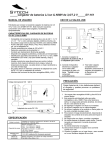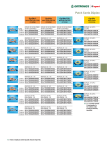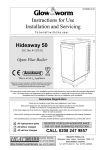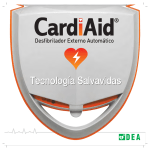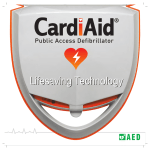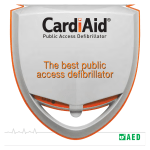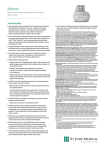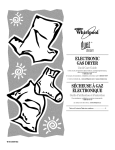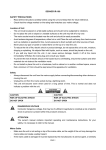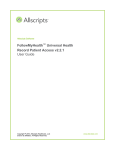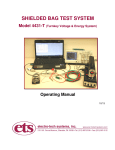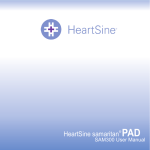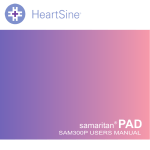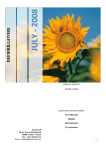Download User Manual for the CardiAid AED
Transcript
User Manual and Introduction to the Device For Models CT0207RS and CT0207RF ENGLISH User Manual and Introduction to the Device For Models CT0207RS and CT0207RF Contents ENGLISH Overview of CardiAid CT0207RS & CT0207RF ............................................... 3 1. Introduction to the Device ..................................................................... 6 1.1 Intended Use ......................................................................................... 6 1.2 User Qualification ................................................................................. 6 1.3 Description of the Functions................................................................. 6 1.4 Indications for Use ................................................................................ 8 1.5 Contraindications for Use ..................................................................... 8 1.6 Important Points in an Emergency........................................................ 8 2. User Manual ............................................................................................. 9 2.1 Description of the User Manual ........................................................... 9 2.2 Labels on the Device and its Accessories .......................................... 10 2.3 Safety Rules ........................................................................................ 11 General Rules............................................................................................ 11 Defibrillation / Use ................................................................................... 12 Electrodes ................................................................................................. 13 2.4 Side Effects ......................................................................................... 14 3. Preparing CardiAid for Use ................................................................. 15 4. Operation ................................................................................................ 16 4.1 Before Using CardiAid ........................................................................ 16 4.2 Providing Reanimation........................................................................ 16 4.3 After Using CardiAid........................................................................... 20 4.4 Operation Documentation .................................................................. 20 5. Hygiene ................................................................................................... 21 6. Function Test .......................................................................................... 22 6.1 Periods of User Tests.......................................................................... 22 6.2 Function Check .................................................................................... 22 7. Troubleshooting..................................................................................... 23 8. Disposal .................................................................................................. 25 9. Storage .................................................................................................... 26 10. Maintenance .......................................................................................... 27 10.1 After-Use Maintenance .................................................................... 27 10.2 Periodical Maintenance.................................................................... 27 11. Package Content ................................................................................... 28 12. Technical Information .......................................................................... 29 12.1 Technical Specifications................................................................... 29 12.2 Pulse Form ........................................................................................ 35 13. Address Information ............................................................................. 36 2 ENGLISH Overview of CardiAid CT0207RS & CT0207RF CT0207RS 1. Device Cover 2. Socket for Electrode Plug 3. Loudspeaker 4. Emergency Kit 5. Defibrillation Electrodes 6. Protection Bag 7. Indicator Window 8. Indicator: “Remove clothing from chest and stick on electrodes.” 9. Indicator: “Do not touch the patient from now on.” 10. Indicator: “Patient may be touched.” 11. Indicator: “Ready for Shock.” (only for CT0207RS) 12. Shock Button (only for CT0207RS) 13. Info-Button 14. Repair Symbol 15. Battery Symbol 16. OK Symbol 3 ENGLISH Overview of CardiAid CT0207RS & CT0207RF CT0207RF CardiAid Emergency Kit a. CPR Mask b. Razor c. Scissors d. Gloves e. Alcohol Pad 4 1. Device Cover CardiAid is switched on by opening the cover and switched off by closing the cover. Closing the cover will switch off the device only after the electrodes are disconnected. 2. Socket for Electrode Plug Electrodes are connected to CardiAid through this socket. Electrodes supplied with the device are already connected to this socket. 3. Loudspeaker Audio warnings of the CardiAid are heard through this loudspeaker. 4. Emergency Kit Emergency kit includes scissors, shaver, respiration mask, gloves, and alcohol pad. Emergency kit should be replaced after use. 5. Defibrillation Electrodes Electroshock is delivered to the patient through these electrodes. Electrodes should be replaced after each use. 6. Protection Bag Protection bag is used to store, carry, and protect the device. 7. Indicator Window The status of the device can be observed through this window on the protection bag. 8. Indicator: “Remove clothing from chest and stick on electrodes.” When this indicator lights, you should stick the electrodes on patient’s bare chest. 9. Indicator: “Do not touch the patient from now on.” Patient should not be touched when this indicator is flashing. For example: During heart rhythm analysis and shock application. 10. Indicator: “Patient may be touched.” While this indicator is lighting, patient may be touched. For example: During cardiopulmonary resuscitation. 11. Indicator: Ready for Shock (only for CT0207RS) This indicator flashes when CardiAid is ready to deliver shock. 12. Shock Button (only for CT0207RS) Shock button starts flashing after shock is prepared. This button is pressed to deliver electroshock. 13. Info-button When pressed, an audible notification indicating the duration of use and number of shocks applied is heard. 14. Repair Symbol The device should not be used, if the repair symbol is flashing or lighting. In this case, it should be repaired by Cardia International or an authorized service provider of Cardia International. 15. Battery Symbol The device is not ready for use, if the battery symbol is flashing or lighting. In this case, contact Cardia International or an authorized service provider of Cardia International immediately. 16. OK Symbol CardiAid is ready for use, if the OK symbol is flashing while the device is switched off. 5 ENGLISH Overview of CardiAid CT0207RS & CT0207RF 1. Introduction to the Device ENGLISH 1.1 Intended Use CardiAid is a public access defibrillator (PAD), i.e. an automated external defibrillator (AED) which is available for public use. CardiAid can be used for the resuscitation of patients older than 8 years (>25kg) with standard electrodes and patients 1 to 8 years old (<25kg) with special paediatric electrodes. If a patient displays symptoms of a cardiac arrest due to ventricular fibrillation or ventricular tachycardia, CardiAid can be used to deliver the required defibrillation therapy directly on the site of the emergency. The user is guided through the resuscitation process with clear and comprehensible instructions. The device automatically records and analyses the ECG signal and, if required, prepares itself to deliver a shock to the patient. The process by which the shock is delivered varies according to the version of CardiAid being used: • In the semi-automatic version (CT0207RS), the user is asked to press a button to release the shock. • In the full-automatic version (CT0207RF), the device warns the user not to touch the patient and then proceeds to releasing the shock automatically. Important! CardiAid should be used only for the purposes described above. 1.2 User Qualification In most countries, public access defibrillators (PAD’s) like CardiAid can be used by any rescuer who is present when a person has sudden cardiac arrest. In some countries, CardiAid can be used only by rescuers who are qualified with training in basic life support, use of automated external defibrillators and use of CardiAid. 1.3 Description of the Functions CardiAid is used to deliver defibrillation to a person having sudden cardiac arrest due to ventricular fibrillation or ventricular tachycardia. It analyses the heart rhythm of the patient and decides whether an electroshock is necessary or not. If one is necessary, it prepares the shock automatically. The shock delivery method depends on the model used (semi-automatic or fully-automatic). After the shock (or when no shock is advised), CardiAid directs the rescuer to basic life support (CPR) and guides the user with verbal instructions and metronome. During the incident, duration of use and number of shocks delivered can be heard by pressing “info-button”. CardiAid also records the ECG and event data in its internal memory and this data can be obtained from the device as a report. Below, the functions of the devices are explained briefly, and also will be explained in further detail through this user manual. Visual and Acoustic Instructions for the User CardiAid is designed to guide the user with verbal instructions together with pictures, flashing lights of different colours at the same time, thus maximizing the performance. CardiAid starts verbal instructions as soon as its cover is opened and guides the user step by step through the resuscitation process. Simultaneously, clear images support the verbal instructions. The pictures are simple and explanatory; the flashing lights are designed to emphasize the pictures and buttons, with white flashing light showing the stage of the process and red flashing light only indicating the shock button. In this way, all steps are ensured to be implemented accurately even if the user has limited knowledge or experience in resuscitation. 6 1. Introduction to the Device ENGLISH ECG Analysis and Recording When electrodes are placed on the patient correctly, CardiAid immediately starts analysing and recording the ECG. According to the result of this analysis, CardiAid decides whether defibrillation is necessary or not; and informs the user accordingly. CardiAid continues analysing the heart rhythm until the device is turned off. The ECG analysis is continued also during the charging of the device. The electroshock is aborted if the device detects a change in the rhythm. A change from “Shock necessary” to “Shock not advised” is the result of a change in patient’s condition and is not a malfunction. Attention! CardiAid is turned off by unplugging the electrodes and closing the cover of the device. Closing the cover of the device when electrodes are still plugged in and connected to the patient does not stop the operation. Defibrillation If CardiAid detects a rhythm which requires defibrillation (Venticular Fibrillation (VF) or Venticular Tachycardia (VT)); it informs the user and prepares the electroshock. In semi-automatic model (CT0207RS), CardiAid instructs the user to press the shock button to deliver the electroshock. In the full-automatic model (CT0207RF), the device warns the user and delivers the electroshock automatically. The user cannot deliver an electroshock unless the device detects a shockable rhythm and prepares the electroshock. CPR Guidance In the basic life support phase, CardiAid guides the user according to the latest resuscitation guidelines. It provides metronome signals so that the user can perform chest compressions with the correct rhythm and number. After 30 signal tones, verbal instruction “Now give 2 mouth to mouth breaths” is heard, followed by a short silence for rescue breaths. Then, the user is directed to chest compressions with the verbal instruction: “Now make 30 chest compressions”. This cycle is repeated for 2 minutes according to the latest resuscitation guidelines. Info-Button By pressing the Info-button during basic life support stage, duration of use and number of shocks delivered can be heard. During this time, the timer for basic life support continues in the background. Application Documentation CardiAid records ECG and incident data in its internal memory. These data may be obtained from the device as a report to be analysed by specialists to define subsequent treatment. Self-testing CardiAid performs an automatic self-test daily, monthly and each time the cover is opened (i.e. when the device is switched on). The status of the device is indicated with flashing status symbols on the front side of the device. 7 1. Introduction to the Device ENGLISH 1.4 Indications for Use CardiAid is indicated to be used on victims of sudden cardiac arrest when; • The patient is unconscious an unresponsive, • The breathing is absent or not normal. CardiAid CR-13A Adult Defibrillation Electrodes should be used for patients older than 8 years or weighing more than 25kg. CardiAid CR-13P Paediatric Electrodes should be used if the patient is 1 to 8 years old or weighs less than 25kg. Therapy should not be delayed to determine the exact age or weight of the patient. 1.5 Contraindications for Use CardiAid should not be used if any of the following signs are present: • Consciousness and/or responsiveness • Breathing 1.6 Important Points in an Emergency If you suspect that a person is having sudden cardiac arrest, keep in mind the following points: 1. Keep calm and proceed rapidly. 2. Check consciousness and breathing. • Check the victim for a response. Gently shake the shoulders and ask loudly: “Are you all right?” • Check for normal breathing. Caution! CardiAid should be used and defibrillation can be delivered only when the person is unconscious and the breathing is absent or not normal. 3. Phone emergency services and provide the following information: • Your name • Your current location • Number of patients • Type of emergency (suspicion of sudden cardiac arrest) • Presence of a defibrillator (PAD/AED) Attention! While starting resuscitation, make sure the emergency number is called without delay (preferably by other people around you). 4. Open the cover of CardiAid. The device will switch on automatically. 5. Follow the instructions exactly. See Section 4 “Operation” for detailed information regarding the verbal instructions. Caution! Note that the information in this user manual does not substitute a basic life support training. 8 2. User Manual Danger! The icon defines a danger which can result in serious injury or death. Caution! The icon defines a possible danger which can result in serious injury or death. Warning! The icon defines a possible danger which can result in simple - mild injury. This symbol is also used to indicate user errors which can result in damage to the device. Attention! This icon provides necessary additional information. 9 ENGLISH 2.1 Description of the User Manual Please read this user manual carefully to ensure safe and effective use of CardiAid and to be prepared in case of an emergency. If you have additional questions about information in the user manual, you may contact the local distributor or Cardia International directly. Keep this manual where it can be reached easily. The following safety warning icons are used throughout the manual: 2. User Manual ENGLISH 2.2 Labels on the Device and its Accessories Type Plate Label CD02BTL001 Battery Pack for CT0207/CT0207RS/CT0207RF Model No: CA-4BP 12V-15Ah-Alkaline Battery Life Label Cardia International A/S, Hersegade 20, 4000 Roskilde, Denmark www.cardiaid.com Battery Product Label (on battery) Electrode Product Label Serial number of the device Do not re-use. Date of manufacture Keep dry. Do not dispose the device in common household waste. Defibrillation protected, type BF patient connection Avoid physical impact. Bluetooth Keep away from fire. Consult instructions for use. Do not dispose in household waste. IP55 Dust protected, protected against water jet 10 Model: CR-13A Avoid physical damage. Keep away from sunlight. Manufacturer Do not use if package is damaged. High voltage Use-by period after package opened Replace battery before this date. Part number Caution: Further information in user manual. Use-by date Temperature limits Batch code Humidity limits Transport and store this side up. Atmospheric pressure limits Fragile, handle with care. 2. User Manual 2.3 Safety Rules ENGLISH To ensure safety of the user, the patient and the bystanders, please pay attention to the following safety instructions which are the requirements of Directive 93/42/EEC: General Rules Danger! To prevent danger of explosion, keep CardiAid away from oxygen sources, flammable anaesthesia gases and other flammable substance or gas mixtures. Caution! CardiAid can be used for the resuscitation of patients older than 8 years (>25kg) with standard adult electrodes and patients 1 to 8 years old (<25kg) with special paediatric electrodes. Caution! If you suspect that a person is having sudden cardiac arrest, check for signs of life, i.e. consciousness and breathing, before using the device. CardiAid should be used and defibrillation can be delivered only when the person is unconscious and the breathing is absent or not normal. Caution! Check CardiAid and its accessories for visual damage before using the device. If you observe damage on the device or its accessories, do not use it. Otherwise there may be functional errors resulting in the injury of both the patient and the user. Caution! Do not use the device if you observe differences in the procedures from the ones described in the user manual. In this case, immediately contact Cardia International or a Cardia International authorized service provider. Caution! CardiAid can be used only after self-test is completed successfully and any damage or misuse is not detected. Caution! Check periodically whether the device and its accessories are ready for use (See Section 6.2. Function Check for further details). Caution! Use the device only in dry and non-conductive environments. Using CardiAid and delivering defibrillation on a wet or conductive surface or in a humid environment may cause injuries (electrocution, burning etc.) of the patient, user and / or the by-standers. 11 2. User Manual ENGLISH Caution! Do not attempt to deliver electroshock if defibrillation electrodes are in contact with each other or are not connected to the patient. Danger! Be sure that the electrode cable is not wedged when closing the cover of CardiAid. It may damage the electrode cables. Caution! Charging and delivering electroshock may affect the electronic devices nearby. Check the function of these devices before using CardiAid. Warning! Operation of CardiAid can be affected from electrical and magnetic fields. Keep CardiAid at least 2 meters away from electrical devices such as cellular phones, walkie-talkies, X-ray machines etc. Warning! Do not immerse CardiAid or its accessories in any liquid. Liquid ingression may cause serious damage and the device can be unusable. Warning! Use only original accessories and spare parts. Using incompatible accessories or spare parts can cause irreversible damage to the device and serious injuries. Use of nonapproved accessories and spare parts invalidates the warranty of your device and the manufacturer will not be responsible for any damages caused. Defibrillation / Use Caution! Always observe national / regional laws and regulations in effect regarding the use of an automated external defibrillator. Caution! To prevent injuries of the user, the patient and any by-stander, make sure the patient is not being touched or moved during defibrillation. Do not touch metal objects or equipment which are in contact with the patient during defibrillation. Caution! Apply the electrodes on patient’s bare chest as shown on the electrode pads. Applying electrodes incorrectly may cause faulty analysis of heart rhythm and / or faulty or inefficient defibrillation. 12 Caution! In order to prevent faulty interpretation of ECG data, make sure that the patient is lying still, not being touched or moved while CardiAid is analysing heart rhythm. Do not perform basic life support (CPR) during rhythm analysis. Warning! Before delivering the electroshock, make sure the patient is disconnected from other medical devices which do not have defibrillation protection. Warning! Although CardiAid is one of the safest devices in its class, remember that wrong interpretation of heart rhythm may be possible. Warning! Make sure that the electrodes are placed firmly to the patient’s chest. If not, air between the patient’s skin and electrodes can cause burns. Electrodes Caution! Only use original electrodes supplied with CardiAid. CardiAid CT0207RS and CardiAid CT0207RF should be used with CardiAid CR-13A Adult Defibrillation Electrodes or CardiAid CR-13P Paediatric Electrodes. Caution! CardiAid CR-13A Adult Defibrillation Electrodes should be used for patients older than 8 years or weighing more than 25kg. CardiAid CR-13P Paediatric Electrodes should be used if the patient is 1 to 8 years old or weighs less than 25kg. Therapy should not be delayed to determine the exact age or weight of the patient. Caution! Never use electrodes which have damage on the package and / or on the pads. Do not use electrodes after the expiry date written on the electrode package. Caution! Open the electrode package only in case of an emergency and just before use. 13 ENGLISH 2. User Manual ENGLISH 2. User Manual Caution! If the patient has an implanted pacemaker, do not stick the electrodes on the pacemaker. Using the defibrillator on a patient with implanted pacemakers can lead to incorrect analysis of the heart rhythm and to irreversible damage of the myocardium in case the electrodes are placed too close to the pacemaker. Caution! Do not place the electrode pad on the nipple. Caution! If there is excessive hair on chest, use the razor in the emergency kit of CardiAid (present inside the cover of the device) to clear the chest before applying electrode pads. Caution! Remove all clothing from upper body before applying electrode pads. Clothes or undergarments with metal parts may cause burns on skin. Caution! CardiAid defibrillation electrodes are for single-use only. After using CardiAid, immediately contact Cardia International or an authorized service provider for replacement of the electrodes. Caution! Pay attention to the operating and storage conditions of the device and its accessories, which are indicated in technical specifications. Caution! Keep and store the device and its accessories away from children. Electrode cables may cause suffocation. 2.4 Side Effects The following adverse side effects may occur when CardiAid is used: • Burns on skin • Rashes on skin • Delivering electroshock to a patient who has implanted pacemaker or is connected to other electronic devices can cause damage to these devices. • Delivering electroshock to a patient having a non-shockable rhythm may cause fibrillation. 14 Unpacking the Device Remove CardiAid from its packaging carefully. Check whether all parts are present according to “Content of Delivery” on Section 11. Check all components for any sign of damage. Contact your sales representative or Cardia International directly if there are any missing or damaged components. Opening the Cover Open the cover of CardiAid. Device will switch on automatically. Connecting Electrode Plug CardiAid is delivered with electrodes pre-connected to the device. Always keep the device in this condition to help save time in an emergency. If not connected already, connect the electrode plug to the socket on the device. Special design of the plug prevents user mistake. It can only be connected as required. Placing Emergency Kit CardiAid is delivered with an emergency kit placed inside the cover of the device and electrodes placed inside the package in front of the emergency kit. Always keep the device in this condition to help save time in an emergency. Emergency kit includes a single-use razor, scissors, respiration mask, gloves, and alcohol pad. The items in the emergency kit are for single-use only. After using CardiAid, contact Cardia International or an authorized service provider for replacement. Closing the Cover Close the cover of CardiAid carefully. The device will switch off automatically. Danger! Make sure that the electrode cable is not wedged while closing the cover of the device. It may damage the cable. Installation Different storage options are available for CardiAid. You can choose the product which suits your needs the best: • CardiAid Wallmount: It provides practical storage for CardiAid AED. CardiAid Wallmount also provides storage for spare electrodes, if necessary. • CardiAid Indoor Cabinets: Specially designed for CardiAid, they ensure that CardiAid AED is noticeable and easily reachable in case of an emergency while providing its safety. • CardiAid Outdoor Cabinet: It provides climate protection and high visibility outdoors. Installation instructions and necessary parts are included in the packaging of the products. 15 ENGLISH 3. Preparing CardiAid for Use 4. Operation 4.1 Before Using CardiAid ENGLISH Switching CardiAid On Open the cover of CardiAid. Device will switch on automatically. Self-testing CardiAid immediately starts a self-test when switched on. During self-test, all indication and warning LEDs light up. When self-test is completed, indication symbols show the status of the device. Observe the status indicators before continuing to use CardiAid. Green “OK Symbol” flashing indicates that the device is ready to use. The combination of the status indicator lights have different meanings. See Section 7. Troubleshooting for further details. Caution! If the green “OK Symbol” is not flashing, the device is not ready to use. Immediately contact Cardia International or an authorized service provider. Caution! If any of the red “Battery Symbol” or “Repair Symbol” is flashing, immediately contact Cardia International or an authorized service provider. See Section 7. Troubleshooting for further details. Caution! If the red “Battery Symbol” is flashing, indicating a low battery, immediately contact Cardia International or an authorized service provider. The battery should be replaced after max. 3 years or when the device gives low battery warning. Warning! Red “Repair Symbol” flashing together with the green “OK Symbol” indicates a warning that the electrode is not plugged, rather than a problem affecting the operation of the device. If you observe this situation, plug the electrode to the device. Caution! If one or more of the instruction lights does not light during self-test, the light diodes may be faulty. The device may be used in the current incident, if there is an emergency. Immediately contact Cardia International or an authorized service provider for repair. 4.2 Providing Reanimation After opening the cover, verbal and visual instructions guide the user through the whole reanimation process. In this section, you may find details on how to act on each verbal and visual instruction given. Caution! Note that the information in this user manual does not substitute a basic life support training. 16 4. Operation Preparation of defibrillation 1. “Check for breathing” and “Phone emergency services” (This instruction may be differentiated to fit the national emergency number in your country.) (These instructions can be deactivated by an authorized service provider) verbal instructions are heard immediately after opening the cover of CardiAid. The LEDs around the indicator of the first instruction field (on the left) light. While starting resuscitation, make sure that the emergency number is called without delay (preferably by other people around you). Check the patient for the following signs of life: • Consciousness • Normal breathing CardiAid should be used and defibrillation can be delivered only when the person is unconscious and the breathing is absent or not normal. 2. “If not breathing normally, remove clothing from chest and stick on electrodes” (This instruction can be deactivated by an authorized service provider) instruction is heard. Position the patient on his back on a non-conductive and dry surface. Remove clothing from patient’s chest. Patient‘s chest should be dry and not very hairy. If necessary, remove hair using the razor in the emergency kit. 3. “Stick electrodes on patient’s bare chest.” Open the package of the electrodes. Stick electrodes on patient’s bare chest as shown on the electrode pads. Press the electrodes firmly to guarantee a good contact. The instruction “Stick electrodes on patient‘s bare chest.” is repeated every 8 seconds until electrodes are placed correctly to enable the heart rhythm analysis. If an electrode is detached or damaged, the instruction is repeated until the contact between the electrodes and the body is reestablished. Caution! CardiAid CR-13A Adult Defibrillation Electrodes should be used for patients older than 8 years or weighing more than 25kg. CardiAid CR-13P Paediatric Electrodes should be used if the patient is 1 to 8 years old or weighs less than 25kg. Therapy should not be delayed to determine the exact age or weight of the patient. 17 ENGLISH Caution! The cover of the device should not be closed during operation. 4. Operation ENGLISH Caution! During the whole process, make sure that electrodes are placed firmly on chest and are not damaged. 4. “Do not touch the patient from now on. Analysing heart rhythm” These instructions are heard when electrodes are placed correctly, enabling the analysis of the heart rhythm (ECG). Simultaneously, the green light and LEDs around the second instruction field (in the middle) light, which indicates that the patient should no longer be touched or moved. Caution! Patient should not be touched or moved during heart rhythm analysis. Do not perform basic life support during the analysis. This may cause wrong interpretation of the ECG and delay in the defibrillation process which can be life threatening. If the patient is touched or moved during analysis which cause interruption in the analysis, a signal tone and the warning “Movement detected.” are heard. Caution! When warning “Movement detected” is heard, check for the cause of the interruption. If the patient is on a vehicle, stop the vehicle. After the heart rhythm analysis, CardiAid decides whether shock is required. The device proceeds with verbal instructions according to the results of the analysis. These instructions will be explained in the following sections “Shock Necessary” and “Shock Not Advised”. Shock Necessary 5. If a shockable rhythm (Ventricular Fibrillation (VF) or Ventricular Tachycardia (VT)) is detected, instruction “Shock necessary. Do not touch the patient from now on!” is heard and CardiAid starts preparing the electroshock automatically. The instruction “Preparing shock.” is heard next. Attention! The process by which the shock is delivered varies according to the version of CardiAid being used: • In the semi-automatic version (CT0207RS), the user is asked to press a button to release the shock. • In the full-automatic version (CT0207RF), the device warns the user not to touch the patient and then proceeds to releasing the shock automatically. For CT0207RS: 6a. When the device is ready for defibrillation, the instruction “Press the flashing shock button” is heard. At this moment, also the LEDs around the shock-button start flashing and the button is activated. This instruction is repeated with a signal tone until the shock button is pressed. Press the shock button to deliver the shock. 18 4. Operation ENGLISH For CT0207RF: 6b. When the device is ready for defibrillation, the instruction “Shock will be delivered” is heard with a repeating signal tone until the device delivers the electroshock automatically. 7. After the shock delivery, the instruction “Shock delivered” is heard. The device continues analysing heart rhythm while shock is being prepared. If the heart rhythm changes during this period, defibrillation is aborted. Danger! There is always a risk of electrocution for the user and the by-standers. Make sure that nobody touches the patient and there is no electrical connection in the surrounding or on the floor which may transmit electricity. Otherwise, life threatening injuries may occur for the user and the by-standers. You can touch the patient only after hearing the instruction “Patient may be touched”. Basic Life Support 8. After delivering the electroshock, CardiAid proceeds to basic life support. The instruction “Patient may be touched. Carry on resuscitation: alternately make 30 chest compressions and give 2 mouth-to-mouth breaths.” is heard. Simultaneously, the green light and LEDs around the second instruction field (in the middle) light, which indicates that the patient can be touched from the moment. CardiAid also provides metronomic signals to guide the rescuer with the correct rhythm and number for the chest compressions. After 30 signal tones, verbal instruction “Now give 2 mouth to mouth breaths” is heard, followed by a short silence for rescue breaths. Then, the user is directed to chest compressions with the verbal instruction: “Now give 30 times chest compressions”. This cycle is repeated for 2 minutes according to the latest resuscitation guidelines. Caution! If you detect signs of life like consciousness or breathing during resuscitation, proceed as indicated in section “Signs of Life Present”. Caution! After basic life support, recheck the status of electrodes. If necessary, press the electrodes firmly on patient’s chest to re-establish the contact. After 2 minutes according to the current resuscitation guidelines, a new heart rhythm analysis starts (See Section 4) and second instruction field (in the middle) lights. Shock Not Advised After heart rhythm analysis; if CardiAid detects normal sinus rhythm, asystole or another rhythm which is inappropriate for defibrillation, the instruction “Shock not advised” is heard and CardiAid proceeds to “Basic Life Support” phase. 19 ENGLISH 4. Operation Analysis Result If CardiAid cannot perform a clear heart rhythm analysis due to incorrect electrode connection or inadequate signal level which is a result of touching or moving the patient, the warning “Movement detected. Do not touch the patient from now on.” is heard. CardiAid will attempt another heart rhythm analysis. If the analysis is successful, device proceeds according to the results as explained in sections “Shock Necessary” or “Shock Not Advised”. If the second attempt is also unsuccessful, the device proceeds to “Basic Life Support” phase. Signs of Life Present If you detect signs of life like consciousness and normal breathing during operation of the device, place the patient in recovery position (lying on one side). Do not remove electrodes. CardiAid will continue operating normally. Heart rhythm analysis will be performed regularly. If the patient loses consciousness again and “Shock necessary” instruction is heard, place the patient on his back again and follow CardiAid‘s instructions. Information Function During operation of CardiAid, information about the duration of use and the number of shocks delivered may be obtained. Press info-button to obtain this information. Information can only be provided while electrodes are not connected or the basic life support is being performed. The infobutton is not active during heart rhythm analysis and shock delivery phase. If info-button is pressed at these stages, the information will be provided when CardiAid proceeds to basic life support phase, or the electrodes are disconnected. 4.3 After Using CardiAid • Remove the plug of the electrodes from the socket. • Close the cover of the device. • Contact Cardia International or a Cardia International authorized service provider immediately after use. • Remember that electrodes and the emergency kit are disposable and should be replaced after use. 4.4 Operation Documentation Operation Data The following information is saved automatically in the internal memory of the device for every use: • Date and time of use • Patient’s ECG • Time of each voice prompt • Time of important points in resuscitation like when the device starts and finishes the analysis, what the result of the analysis is and when the shock-button is pressed • Time and number of shocks delivered Contact Cardia International or a Cardia International authorized service provider immediately after use. 20 5. Hygien CardiAid can be cleaned by a piece of cloth which is moistened (but not saturated) with a simple disinfectant. ENGLISH Caution! Do not immerse CardiAid or its accessories in any liquid. Liquid ingression may cause serious damage and the device can be unusable. 21 6. Function Test ENGLISH CardiAid performs an extensive self-test periodically on stand-by status (cover closed). Additionally, a self-test is performed at the start of each operation (when cover is opened). The result of the self-test is indicated with status ındicators: battery symbol, repair symbol and OK symbol. In addition to these periodical self-tests, functions of CardiAid should be checked on a regular basis. 6.1 Periods of User Tests Daily Check the status indicator symbols of CardiAid daily. If the green OK symbol is flashing in stand-by position, CardiAid is ready for use. If the red “Battery Symbol” or “Repair Symbol” is flashing, see Section 7. Troubleshooting. If the problem persists, contact Cardia International or an authorized service provider immediately. Semi-annual Perform a function check every 6 months. (See Section 6.2. Function Check for details) 6.2 Function Check Perform function check every 6 months as explained below. If you observe an error or discrepancy in the values, do not use the device and try to solve the problem by yourself by referring to Section 7. “Troubleshooting”. If the problem cannot be solved, contact Cardia International or a Cardia International authorized service provider immediately. 1. Check the status indicator symbols while CardiAid is in stand-by mode (the cover is closed). If the OK symbol is flashing in stand-by mode, CardiAid is ready for use. 2. Open the cover of CardiAid. If the following conditions are met, the device is ready to use: • All lights and status indicator symbols light simultaneously for a short period of time. • Then, OK symbol lights continuously. • CardiAid starts giving verbal instructions. 3. Close the cover again and make sure that the device is in stand-by mode. If verbal instructions stop and OK symbol starts flashing, CardiAid is ready for use. 4. Inspect the appearance of the device. Check if the device has external damage. If the device is damaged, it shouldn’t be used. 5. Check whether all accessories are complete and unused. Missing or faulty parts should be renewed immediately. 6. Check whether the electrode connector is plugged in the socket correctly. If the electrode plug is not connected correctly, press the plug firmly to the socket. 7. Check whether the electrode plug, electrode cables and the electrodes are in good condition. If the plug, cables or the pack is damaged, electrodes should be replaced immediately. 8. Make sure that the electrode pack has not passed its expiration date. If it is expired, the electrode pack should be replaced immediately. 22 7. Troubleshooting Failure Messages of CardiAid Visual Acoustic Battery Symbol and OK Symbol are flashing during stand-by. Battery Symbol and OK Symbol are lighting continuously during operation. Cause Action Signal tone in every hour CardiAid can be used only in Battery is low. Battery emergencies. Contact Cardia can only supply a limited International or an authorized number of shocks. service provider immediately for battery replacement. “Battery low.” CardiAid can be used only in Battery is low. It can only emergencies. Contact Cardia supply a limited number International or an authorized of shocks. service provider for battery replacement. Battery Symbol and Signal tone in Repair Symbol are every hour flashing during stand-by. ENGLISH Danger! Inspection, repair and other maintenance actions can be performed only by Cardia International or a Cardia International authorized service provider. Do not attempt to unscrew the device. This invalidates the warranty, may cause serious injuries and/or irreversible damage on the device. Battery is empty. Device cannot be used. Contact Cardia International or an authorized service provider immediately. Battery Symbol and Repair Symbol are lighting continuously during operation. “Battery low.” or “Device is not ready for use.” Battery is empty. Device cannot be used. Contact Cardia International or an authorized service provider immediately. OK Symbol and Repair Symbol are flashing during stand-by. No acoustic message The electrodes are not connected to the device. Plug the electrodes to the device. OK Symbol and Repair Symbol are lighting continuously during operation. “Plug electrodes into socket.” The electrodes are not connected to the device. Plug the electrodes to the device. Wrong electrodes are being used. Be sure that original CardiAid electrodes are being used. Repair Symbol is flashing during stand-by. Signal tone in every hour There is a malfunction with the device. Device cannot be used. Contact Cardia International or an authorized service provider immediately. Repair Symbol is lighting continuously during operation. No acoustic message There is a malfunction with the device. Device cannot be used. Contact Cardia International or an authorized service provider immediately. 23 7. Troubleshooting Failure Messages of CardiAid ENGLISH Visual None Acoustic Status indicators do not light or flash Any for a period of time during operation. OK Symbol is lighting continuously during operation. “Stick electrodes on the patient’s bare chest” even though the electrodes are placed. Cause Action Problem with LEDs. CardiAid can be used only in emergencies. Contact Cardia International or an authorized service provider immediately. Electrodes are not placed correctly. Press the electrodes firmly. Be sure that the chest is dry and not very hairy. Remove excessive hair, if necessary. Electrodes are defective. Change electrodes. Contact Cardia International or There is a malfunction with an authorized service provider the device. immediately. None Repair symbol is lighting continuously. “Device is not ready for use.” No visual message No acoustic message CardiAid cannot be switched on. Any Any Shock cannot be delivered, even though shock button is flashing. Any 24 Close the cover and open the cover again. If the problem There is a malfunction with persists, contact Cardia the device. International or an authorized service provider immediately. Verbal instructions Contact Cardia International or There is a malfunction with cannot be heard while an authorized service provider the device. CardiAid is operating. immediately. Any Any Contact Cardia International or There is a malfunction with an authorized service provider the device. immediately. Contact Cardia International or There is a malfunction with an authorized service provider the device. immediately. Any The device is not operating as indicated in the operating manual. Any Contact Cardia International or an authorized service provider immediately. 8. Disposal For disposal of used electrical and electronic devices, refer to special collection system for these type of devices in European Union countries and other European countries. The symbol on the product or its packaging indicates that this product cannot be disposed in common household waste. Electrical and electronic devices should be delivered to recycling facilities. With your contribution to disposal of this product, you can help protecting both the environment and its inhabitants. Incorrect disposal methods threaten the environment and health of the community. Material recycling reduces the use of raw materials. You may obtain additional information regarding the recycling of this product from municipal regional disposal facilities or from the dealer you purchased the product. Always consult a licensed analyser of electronic worn-out components for proper disposal of this device. 25 ENGLISH Do not dispose the device to common household waste. For detailed information regarding disposal of the product and its accessories, visit www.cardiaid.com ENGLISH 9. Storage Always obey maintenance and function test schedule, regardless of whether the device is used rarely or stored for long periods. Device cannot be used if one of the maintenances is not performed on time. Always make sure maintenances and periodical controls are performed without delay. Pay attention to the storage condition requirements of CardiAid (see Section 12. Technical Information). Excessive ambient temperature can shorten the battery life considerably. Do not keep CardiAid under direct sunlight. Store CardiAid in dry environment. 26 10. Maintenance ENGLISH CardiAid is subject to maintenance periodically and after each use, as described below. Previously performed maintenances, if there is any, can be tracked from the maintenance label on the device. Periodical Maintenance Label After-use Maintenance Label Danger! Inspection, repair and other maintenance actions can be performed only by Cardia International or a Cardia International authorized service provider. Do not attempt to unscrew the device. This invalidates the warranty, may cause irreversible damage to the device and/ or serious injuries. 10.1 After-Use Maintenance CardiAid should be subject to maintenance by Cardia International or a Cardia International authorized service provider after every use. This ensures that CardiAid is in good condition and ready to use when needed again. During this maintenance, main battery and electrodes are replaced, the incident data is obtained from the device and some function tests are performed. Also, the emergency kit is replaced if used. The next periodical maintenance should be performed at regular time. (See Section 10.2) 10.2 Periodical Maintenance 2nd and 4th Year Periodical Maintenance: CardiAid should be subject to periodical maintenance at the end of 2nd and 4th years after purchase. Date of next maintenance is indicated on the battery life label on backside of the device. During this maintenance, main battery and electrodes are replaced; and some function tests are performed. Caution! The maintenances should be performed no later than the date on the battery life label. The device cannot be used unless the maintenances are performed on time. In some countries like Germany, legal period of Technical Safety Check (TSC) is 2 years according to Medical Products Operation Regulation (Article 6). In these countries, CardiAid should be subjected to TSC during 2nd and 4th year periodical maintenance. 6th Year Maintenance: In order to be able to continue using the device after 6th year, CardiAid should be subjected to a comprehensive maintenance at the end of 6th year after purchase. In addition to the periodical maintenance, the status of technical components is checked. This maintenance is performed at the factory. Please contact Cardia International for details. 27 11. Package Content ENGLISH Caution! Packaging material may cause suffocation. Keep away from children. Refer to local regulations for disposal of packaging material. Standard package of CardiAid contains the following: • CardiAid AED, including battery • CardiAid Protection Bag • CardiAid CR-13A Adult Defibrillation Electrodes • CardiAid Emergency kit (Containing CPR mask, shaver, scissors, gloves, and alcohol pad) • CardiAid User Manual • CardiAid Quick Reference Guide The following accessories and spare parts may be ordered separately: Description of the Item Model Nr. CardiAid Adult Defibrillation Electrodes CR-13A CardiAid Paediatric Defibrillation Electrodes CR-13P CardiAid Emergency Kit CT0207EK CardiAid Protection Bag CT0207P CardiAid Battery Pack CA-4BP CardiAid Trainer (AED Training Unit) CT0207RT CardiAid Featured Indoor Cabinet CC001W CardiAid Basic Indoor Cabinet with Transparent Cover CC002T CardiAid Basic Indoor Cabinet with Metal Cover CC002M CardiAid Outdoor Cabinet CC001T CardiAid Wallmount CT0207W The information above might be subject to change. Please visit www.cardiaid.com for up-to-date information on all products and accessories. 28 12. Technical Information 12.1 Technical Specifications Dimensions l x w x h (in mm)..............................................................................................................................301 x 304 x 112 Weight with battery and electrodes..................................................................................................................................3,1 kg Product class according to Medical Product regulation or Regulation No. 93/42/EEC..........................................................IIb Operation: Temperature limits...................................................................................................................................................... 5°C - 50°C Humidity....................................................................................................................................................................... 0% - 95% Air pressure.......................................................................................................................................................... 572 - 1060 hPa Transportation / Storage: Temperature limits...................................................................................................................................................... 5°C - 50°C Temperature limits: Max. 2 weeks........................................................................................................................-20°C - +70°C Humidity....................................................................................................................................................................... 0% - 95% Air pressure.......................................................................................................................................................... 500 - 1060 hPa Protection class..............................................................................IEC 529: IP55 (Dust protected, protected against water jet) Free drop..............................................................................................................................IEC 601-1:1988+A1: 1991+A2:1995 Electromagnetic compatibility..........................................................................................................DIN EN 60601-1-2:2007-12 Norms................................................................................................................................... EN 60601-2-4:3rd edition, rare use Reanimation protocol........................................................................................................................................ ERC, ILCOR 2010 SELF TEST Schedule.................................................................................. Automatic daily, monthly and when the device is switched on Timing.......................................................................................................................... Can be programmed by factory settings Scope........................................................................................................................... Battery, electronics, software, charging DEFIBRILLATION ELECTRODES Delivery status......................................... Disposable, self-adhesive single use electrodes ready for use, sealed and packed .......................................................................................................................................with connector outside of the package Polarization.......................................................................................................................Not polarized (Exchange is accepted) Cable length......................................................................................................................................................................130 cm Active surface area.............................................................................................................. 166cm2 (adult), 86cm2 (paediatric) Shelf Life.......................................................42 (adult / CR-13A), 36 (paediatric / CR-13P) months from date of manufacture Transportation / Storage........................................................................................................................Between 0°C and 50°C ENERGY SOURCE Type................................................................................................................................................................................. Alkaline Dimensions l x w x h (in mm)..................................................................................................................................260 x 59 x 30 Weight.................................................................................................................................................................................930 g Shock capacity*, **..........................................................................................................................................Up to 210 shocks Minimum capacity..................................................................................................................................................... 100 shocks Monitor capacity*, ***.........................................................................................................................................Up to 20 hours Nominal capacity............................................................................................................................................................... 15 Ah Battery replacement....................................................................................................................Performed by Service Provider Fuse........................................................................................................................................................................................ 15A Stand-by Period*...............................................................................................................................................................3 years Real Time Clock battery lifetime......................................................................................................................................7 years * with a new battery pack, 20°C ** at low energy setting *** at lowest sound level DEFIBRILLATION / ANALYSIS Operating mode.......................................Semi-Automatic (One-button operation) in CT0207RS, Full-automatic in CT0207RF Wave form...................................................................................................................................... Biphasic, Current controlled 29 ENGLISH DEVICE ENGLISH 12. Technical Information Delivered energy at 50 Ω (Adult Mode).............................................................................................. Low energy 170J ± 15% ............................................................................................................................................................. High energy 270J ± 15% Delivered energy at 50 Ω (Paediatric Mode) ........................................................................................ Low energy 50J ± 15% ............................................................................................................................................................... High energy 75J ± 15% Maximum patient impedance ............................................................................................................................................ 250Ω Shock sequence ...............................................................................Constant or escalating, programmable (factory setting) Cycle duration (Analysis and shock preparation) ........................................................................................................................ With fully charged battery ......................................................................................................................................Max. 20 sec. After 15 shocks .......................................................................................................................................................Max. 24 sec. After 6 shocks .........................................................................................................................................................Max. 20 sec. Cycle duration (Switch-on, analysis and shock preparation) ...................................................................................................... With fully charged battery ........................................................................................................................................... < 45 sec. After 15 shocks ............................................................................................................................................................ < 50 sec. After 6 shocks .............................................................................................................................................................. < 45 sec. CPR duration ...............................................................................................................120 sec. (adjustable by factory settings) ECG ANALYSIS SYSTEM Duration of analysis .................................................................................................................................................... < 10 sec. Derivation.................................................................................................................................................................................. II Impedance measurement .........................................................................................................Controlled by electrode contact Movement detection...........................................................................................................................Checks the signal quality ...................................................................................................................................... Acoustic warning at patient movement Reaction to implanted pacemaker ............................Normal cardiac pacemaker rhythm is not detected as being shockable. Asystole threshold .................................................................................................................................................... <0,160 mV Sensitivity VF / pVT*........................................................................................................................................................ > %90 Specificity NSR / Asystole*............................................................................................................................................ > %95 * Report of analysis system can be found in Technical Service Manual, Appendix 1. OPERATION Operating elements .............................................Automatic switch-on when the cover is opened, One-button Operation for ................................................................................................ CT0207RS, full-automatic operation for CT0207RF, Info-button Information Mode .......................................Announcement of the elapsed time and number of shocks since device started, ........................................................................................................................................................when info-button is pressed Display Elements .........................................................................Self-explanatory illuminated symbols (traffic light principle ........................................Device status indicator symbols (OK Symbol, Battery Symbol, Repair Symbol for self-test result) Acoustic Signals .......................................................................................................................................... Verbal instructions ........................................................................................................................................................... Signal tone (when in use) .............................................................................................. Signal tone (in stand-by mode for device failure or low battery) Data Transfer ................................................................................................................... Bluetooth (Only for service provider) BLUETOOTH Class ................................................................................................................................................................................ Class 2 Maximum Output .............................................................................................................................................................. 4dBm Warnings: - Medical electrical equipment should be subjected to special precautions regarding EMC. The following EMC Guidelines must be observed during installation and operation of the device. - Portable and mobile equipment using RF communications may affect medical electrical equipments. 30 12. Technical Information Guidelines and manufacturer declaration – Electromagnetic emissions CardiAid is intended for operation in the electromagnetic environment specified below. HF emissions according to CISPR 11 Group 1 HF emissions according to CISPR 11 Class B Emissions of voltage fluctuations/flicker according to IEC 61000-3-2 N.A. Emissions of voltage fluctuations/flicker according to IEC 61000-3-3 N.A. ENGLISH The customer or user of the device or system should make sure that it is operated in such an environment. CardiAid uses HF energy only for its internal functions. For this reason, its HF emissions are very low and it is not likely that it will interfere with neighbouring electronic devices. CardiAid is suitable for use in all establishments, including residential establishments with similar purposes, which are directly connected to a public power supply, which also supplies buildings used for residential purposes. Recommended safety distances between portable and mobile telecommunication devices (e.g. mobile telephones) and the measuring device Power rating of the HF-device in W Safety distance depending on transmission frequency in m 150 kHz – 80 MHz 80 MHz – 800 MHz 800 MHz – 2,5 GHz 0.01 0.12 0.12 0.23 0.1 0.37 0.37 0.74 1 1,17 1.17 2,33 10 3,69 3,69 7,38 100 11,67 11,67 23,33 For transmitters rated at a maximum output power not listed above, the recommended separation distance d in metres (m) can be determined using the equation applicable to the frequency of the transmitter, where P is the maximum output power rating of the transmitter in watts (W) according to the transmitter manufacturer. NOTE: At 80 MHz and 800 MHz, higher frequency field is applicable. NOTE: At 80 MHz and 800 MHz the separation distance for the higher frequency range is applicable. NOTE : These guidelines may not apply in all situations. Electromagnetic transmission is affected by absorption of and reflection from structures, objects and people. 31 32 Magnetic field for supply frequency (50/60Hz) in acc. with IEC 61000-4-8 Voltage drops, short-term interruptions and fluctuations in the supply voltage in acc. with IEC 61000-4-11 Surges in acc. with IEC 61000-4-5 3 A/m < 5% UT (> 95% drop in UT) for 5 s 70% UT (30% drop in UT) for 25 periods 40% UT (60% drop in UT) for 5 periods <5% UT (> 95% drop in UT) for ½ period ± 2 kV common-mode voltage ± 1 kV series mode voltage ± 1 kV for input/output lines ± 2 kV for power lines 3 A/m N.A. N.A. N.A. ± 8 kV air discharge ± 8 kV air discharge Fast transient electric noise / bursts in acc. with IEC 61000-4-4 ± 6 kV contact discharge ± 6 kV contact discharge Electrostatic discharge (ESD) IEC 61000-4-2 Compliance level IEC 60601 test level Immunity tests The customer or user of CardiAid should make sure that it is operated in such an environment. CardiAid is intended for operation in the electromagnetic environment specified below. Guidelines and manufacturer declaration – Electromagnetic immunity EMC information in acc. with EN 60601-1-2 Magnetic fields for the power-line should have values typical for business and hospital environments. The floor should be made of wood or concrete or be covered with ceramic tile. If the floor is covered with synthetic material, it must have a relative humidity of at least 30%. Electromagnetic environment ENGLISH 12. Technical Information 12. Technical Information Guidelines and manufacturer declaration – Electromagnetic immunity The customer or user of CardiAid should make sure that it is operated in such an environment. Immunity tests IEC 60601 test level Compliance level Electromagnetic environment Portable and mobile wireless devices should not be used at distance from CardiAid (including its power-line cables) smaller than the recommended safety distance. This is calculated according to the equation for the relevant transmission frequency. Recommended safety distance: d = (1.17 m/V) * √ P for 150 kHz - 80 MHz Conducted HF noise in acc. with IEC 61000-4-6 3 Vrms 150 kHz – 80 MHz Radiated HF noise in acc. 3 V/m with IEC 61000-4-3 80 MHz – 2.5 GHz 3 Vrms d = (1.17 m/V) * √ P for 80 MHz - 800 MHz 3 V/m d = (2.33 m/V) * √ P for 800 MHz – 2.5 GHz P being the power rating of the transmitter expressed in W according to the specifications of the transmitter manufacturer, and d the recommended safety distance in m. The field strength of stationary wireless transmitters should be less than the compliance level for all frequencies according to an on-site investigation. Interference can occur in the environment of devices which are marked with the following symbol: REMARK 1:At 80 MHz and 800 MHz, the higher frequency range applies. REMARK 2:These guidelines might not be applicable in all cases. The propagation of electromagnetic parameters is influenced by the absorption and reflection of buildings, objects and human beings. a. Field strengths of fixed transmitters, such as base stations for mobile/portable communication devices, cannot be theoretically predicted with absolute certainty. In order to evaluate the electromagnetic environment based on fixed HF transmitters, an electromagnetic investigation on-site should be considered. If the measured field strength should exceed the HF compliance level specified above in the intended operating environment of the product, the product should be monitored to verify that it functions normally. If abnormal function should be observed, additional measures might be necessary, such as re-orienting or re-positioning the product. b. Field strengths should lie under 3 V/m over the frequency range 150 kHz to 80 MHz. 33 ENGLISH CardiAid is intended for operation in the electromagnetic environment specified below. 12. Technical Information Guidance and manufacturer‘s declaration - electromagnetic emissions ENGLISH CardiAid Public Access Defibrillator is intended for use in the electromagnetic environment specified below. The owner or the user of CardiAid should assure that it is used in such an environment. Immunity Test IEC 60601-1 Test Level Compliance Level Electromagnetic Environment - Guidance conducted RF IEC 61000-4-6 3 Veff 150 kHz to 80 MHz outside ISM bands not applicable for patient instructions according to EN 60601-2-4 Portable and mobile RF communications equipment should be used no closer to any part of the Public Access Defibrillator CardiAid, including cables, than the recommended separation distance calculated from the equation applicable to the frequency of the transmitter. d= 4 * SQRT(P/W) for 80 MHz to 800 MHz For d = 7.67 * root (P/W), d= 7,67 * SQRT(P/W) for 800 MHz to 2,5 GHz Where P is the maximum output power rating of the transmitter in watts (W) according to the transmitter manufacturer and d is the recommended separation distance in metres (m). Radiated RF IEC 61000-4-3 10 Veff 150 kHz to 80 MHz inside ISM-bands not applicable for patient instructions according to EN 60601-2-4 Field strength from fixed RF transmitters, as determined by an electromagnetic site survey, should be less than the compliance level in each frequency range. Interference may occur in the vicinity of equipment marked with the symbol “nonionizing radiation“. 10 V/m 80 MHz to 2,5 GHz 3 V/m NOTE: At 80 MHz and 800 MHz the separation distance for the higher frequency range applies. NOTE : These guidelines may not apply in all situations. Electromagnetic transmission is affected by absorption and reflection from structures, objects and people. Field strength from fixed transmitters, such as base stations for radio (Cellular/cordless) telephones and land mobile radios, amateur radio, AM and FM radio broadcast and TV broadcast cannot be predicted theoretically with accuracy. To assess the electromagnetic environment due to fixed RF transmitters, an electromagnetic site survey should be made. If the measured field strength in the location which the CardiAid Public Access Defibrillator is used exceeds the applicable RF compliance level above, additional measures may be necessary, such as reorientation or relocating the CardiAid Public Access Defibrillator. Above frequency fields between 150 KHz and 80 MHz, field strength should be less than 3 V/m. 34 12. Technical Information The delivered shock is a biphasic current-based shock. Two different energy levels are implemented in the device, a low energy shock and a high energy shock. The current-based shock has the advantage that the delivered energy depends on the patient impedance. Myocardium damage caused by high electrical current applied to patient with low impedance is reduced considerably with this pulse form. Pulse form / shock energy can only be configured by factory. Factory setting is as follows: 1st Shock: Low, 2nd Shock: Low, 3rd and Subsequent Shocks: High Delivered Energy: High-energy adult-impulse at 50 Ohm: 270 J ± 15% Low-energy adult-impulse at 50 Ohm: 170 J ± 15% High-energy paediatric-impulse at 50 Ohm: 75 J ± 15% Low-energy paediatric-impulse at 50 Ohm: 50 J ± 15% Functioning Principle If the current exceeds the specified value, current transmission is interrupted. Current continues to flow to the patient with inductivity in connection path. However, the current falls gradually. If the specified current value exceeds 1 Amp, current transmission re-starts. In this way, current supplied to the patient rises again. This creates a saw tooth pulse. Proportion of supplied electrical current (integral of current in time) between 2nd (negative) and 1st (positive) phases is 0,38 on average. This value is determined as optimal in clinical studies. Current characteristics of high-energy adult-impulses for different patient impedances Impedance Dependence For safety reasons, a current of maximum 2000 Volt is used. Resulting current as a function of patient impedance is shown in the graph. Energy Flow in High Patient Impedance Supplying a fixed current has a determining effect on the energy applied to the patient. Ohm’s law requires higher voltage with increasing impedance. Because the voltage enters the supplied energy quadratic; with increasing resistance, applied energy also rises considerably. This, in turn, provides a better treatment for patients with high impedance and has a positive effect on decreasing death rate in this patient group. 35 ENGLISH 12.2 Pulse Form 13. Address Information ENGLISH Headquarters: Cardia International A/S Hersegade 20 4000 Roskilde Denmark [email protected] www.cardiaid.com 36 CD02MNL001 v.3.0.41107 Cardia International A/S Hersegade 20, 4000 Roskilde, Denmark www.cardiaid.com






































